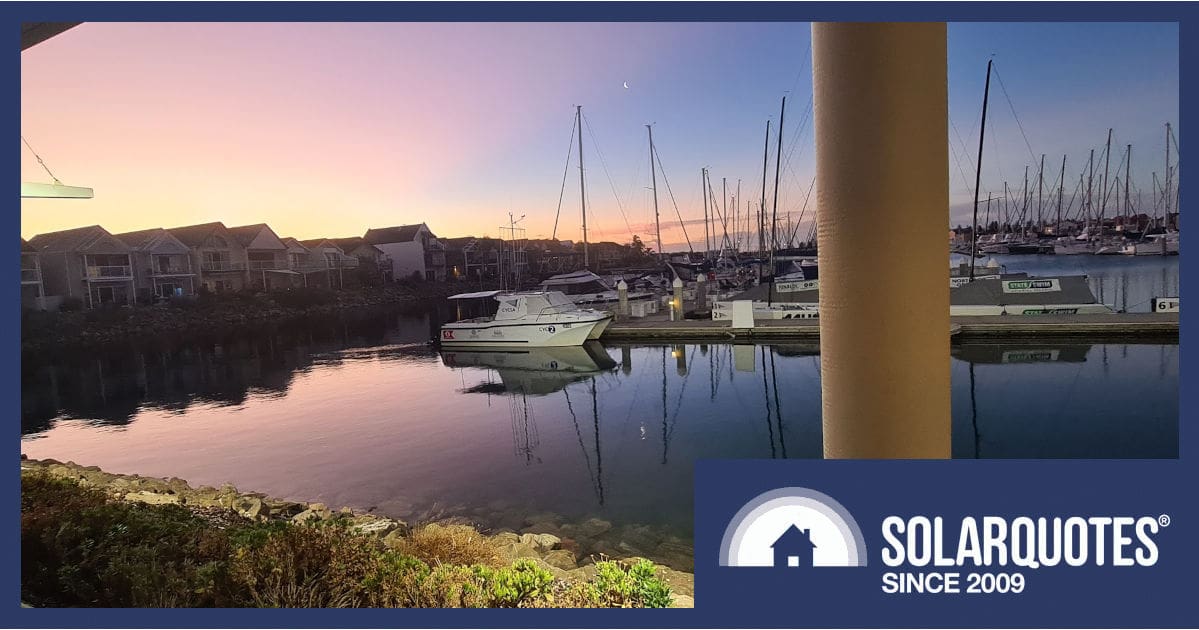
SEIA Adelaide venue.
It’s a tough job, but someone has to show up at the yacht club—strictly for work, of course. The Solar Energy Industries Association (SEIA) roadshow has just swung through Adelaide, and once again, I, your dedicated SolarQuotes installer and blogger, was there. Not for the cold beers and sea breeze, mind you, but to get the scoop on what’s new, from the who’s who in solar. Read on as I explain how this is both a fun day out and critical to maintaining industry excellence.
Solar Energy Industries Association
The SEIA doesn’t run these shows as promotional vehicles for vendors. While the presenters are industry insiders, some with products to sell, their primary role is sharing information, clarifying regulations, and presenting new concepts.
For installers, SEIA offers great value; you’re not spending time and money on sales frippery.
The Importance Of Compliance
Once you’ve done four years of hard graft as an apprentice, completed TAFE training and passed a capstone assessment, an electrical license is yours for life. Solar is different, though. Fast-moving rules, technology and products mean knowledge quickly goes stale.
As a relatively new discipline, solar is tightly regulated. Continual Personal Development is key to keeping everyone on their toes, so every year, I and all other solar sparkies have to accumulate 100 CPD points to prove we’re still interested. One way to earn CPD points is by attending events like this.
Sigenergy In The Flesh
The guys from Sigenergy weren’t handing out merch but they did have hardware on display.
- Aesthetically pleasing monolith
- Covers to conceal wiring so they’re neat like an AlphaESS
- However, the superior fit and finish of Sigen highlights how cheap Alphas are
- There was a continuous stream of interested installers chatting about them.
- DC car charging module was included
- Sadly I didn’t make the opportunity to handle the units as they went back into boxes
Having written a review, it was nice to confirm these machines are not vapourware. There’s some real people involved and they’re happy to get into the comments section and present the case for their product.
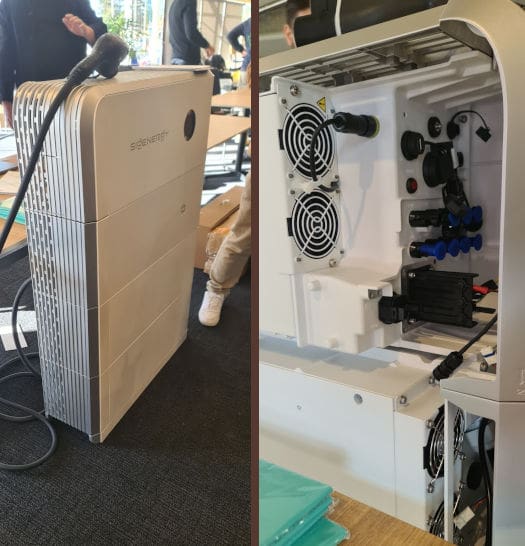
The Sigenergy product was the only unit on the floor and it looks nice.
SA Power Networks
The SAPN team offered their advice on the energy transition. They’re planning to double energy throughput on the network to handle the electrification of transport, plus the removal of gas from everybody’s house, cheerfully explaining how they intend to do it without spending more money.
SA has always had one of the peakiest demand profiles. We have an incredibly tough infrastructure, only fully utilised on a handful of hours, on a handful of stinking hot afternoons. Mostly, the system runs at around 40% capacity. At the heart of it, SAPN wants to better utilise their existing network, spreading more load across more hours and reducing costs for everybody.
SAPN knows EVs will likely be the most significant single appliance anybody installs. And so they’re getting smart about ensuring EV chargers don’t overwhelm the network. Last year they ran paid trials to learn how people use EVs and figure out OCPP control of charging. Already there’s a streamlined process that even I could follow to apply for connection of a new EV charger.
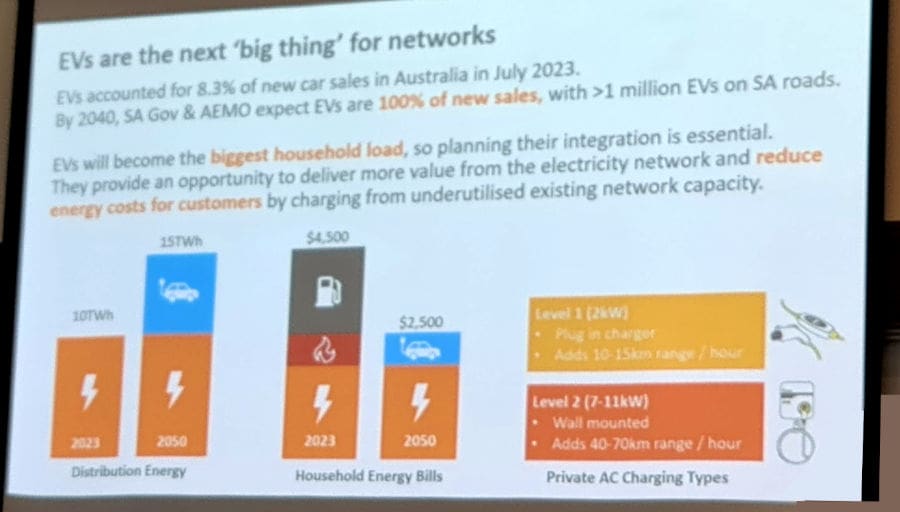
EVs accounted for 8.3% of car sales in mid-2023; SAPN anticipates 100% by 2040
As this graph shows, SAPN expects by 2050, you’ll pay a similar amount to run an all-electric home as a current gas/electric home, but there will be no petrol bill because the energy to run your car will be included. Gas will be gone and better still the expensive poles and wires we already own will handle the increased load more efficiently.
Power+ Lithium Batteries; Explaining Lead Acid
Simon Ceglinsky from Power Plus Batteries is such an entertaining presenter, we’ve decided he should be delivering everybody else’s material too. The Power Plus session reminded me that while lithium batteries are the talk of the town, lead acid refuses to die.
Simon explained, while lithium batteries deliver lots of power quickly, correct sizing an off-grid system battery means you must consider the volume of energy required for an extended run of poor weather.
Lead acid fares well when cycled at 20 per cent of its nominal capacity. A replacement lithium battery is more expensive, but can work harder, so for the same useable capacity, you only have to buy 25% of the comparable lead acid bank.
Yet, lead acid batteries excel in emergencies; they can exceed their cycle ratings by more than double, offering substantial built-in autonomy at no extra cost.
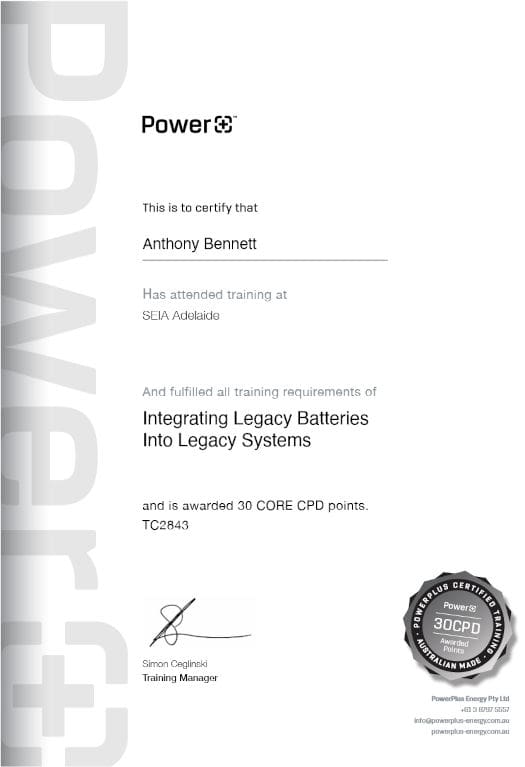
Seal of approval
Even though PowerPlus don’t sell lead acid, they want people to understand the economics and get the right solution
- Purchase a 600Ah 48v lead acid battery, with 28.8kWh nominal capacity for $12,650 ($439/kWh)
- It will deliver 20% Depth of Discharge for donkeys years, or 5.75kWh/day
- At 60% DoD you’ll need to start the generator, repeatedly drawing 17kWh/day will ruin the battery in under 5 years
- However an “equivalent” lithium battery is capable of 80% DoD
- With only 7.2kWh nominal capacity, lithium could deliver the same 5.75kWh/day with a 10 year warranty for $5869 ($815/kWh)
- However, if you need to 250% more energy from the battery (14.4kWh) because the weather is terrible… you’ll have to pour diesel on a generator
- or buy 250% more lithium battery, which isn’t going to be used efficiently if you’re only cycling it to 32% DoD and it costs $14,672
- whereas the lead acid battery has that reserve capacity ready and waiting, for occasional use.
Uber For Energy: A Concept That’s Coming
Scott Young from Catch Power presented one of the most interesting sessions. Everybody’s waiting with bated breath for a three-phase version of their excellent CatchControl relay and energy meter. However, Scott wasn’t there to sell. What he did outline is a theme I’ve been discussing for a while now.
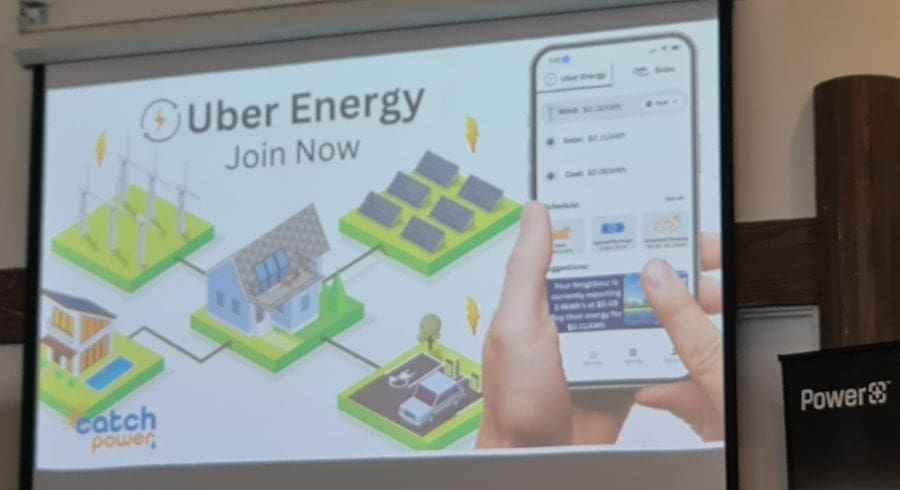
CatchPower got away with branding this slide.
The Disruption Of Energy
Consider this: Uber is one of the world’s biggest taxi companies, yet they don’t own a single car. Airbnb is one of the biggest accommodation providers, and they don’t own a single bed.
Imagine you had a fleet of customers with solar generation and battery storage; add an internet connection and you have what’s called a Virtual Power Plant. Various gentailers like AGL have already been aggregating a lot of small consumer battery plants to create a useful grid scale resource.
Where the old energy industry should be worried is if the software and measuring smarts come from an upstart technology company or an innovator like Amber or LocalVolts, there’s potential to be an energy supply and retail company that doesn’t own a single generator.
For people who use energy, and that’s all of us, there’s a Kodak moment coming. While Apple didn’t invent touch screens, miniature supercomputers or powerful compact batteries, they did combine these three technologies into the iPhone in 2007. After ten years the world was transformed by smartphones.
Our phones aren’t wired to the wall anymore, our electricity is no longer bound to massive steam engines, and our mobility is no longer priced by a cartel of extremist theocracies pumping oil from the Middle East.
Things are really looking up.
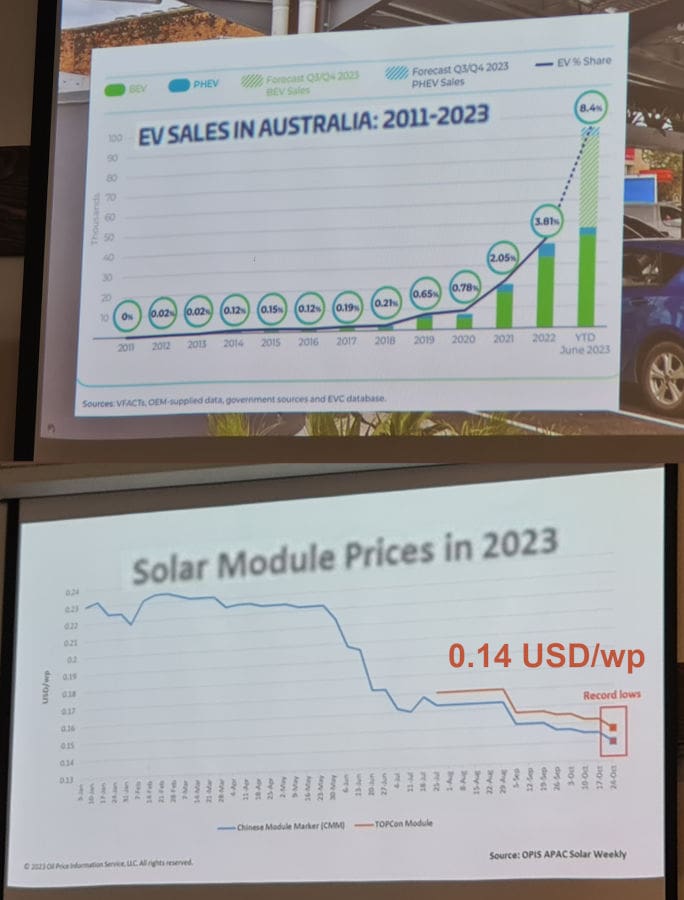
EVs are on the up and PVs are continuing down
We Live In Interesting Times
- Solar is the cheapest electricity ever generated in history which continues to get cheaper.
- The cost of batteries falls with gravity while electric vehicle uptake defies it.
- Just last week, the most significant energy source in California’s evening demand was grid-scale batteries, a technology that didn’t exist ten years ago.
- Solar panel prices plummeted nearly 50% globally in 2023 compared to the prior year as manufacturing capacity has tripled since 2021, according to a January report from the International Energy Agency.
What Does It Mean For You?
There’s always room for improvement, but surveying room at SEIA, I know there’s been vast progress in the last ten years.
Solar Energy Is Still The Bottom Line For The Sunburnt Country.
Our resources aren’t only what we quarry from the ground. What’s overhead is our natural advantage, now available from the world’s most competitive solar installation industry. As prices for solar panels continue to fall and the cost of batteries becomes more affordable, there’s no better time than now to install solar. The STC incentive falls every year too, so waiting for cheaper systems is a fool’s errand when you could be converting sunlight into energy right now.
Don’t get ripped off by a superannuated sportz ball hero, but install as much as you can afford, because if you can size a solar power system to manage your winter demand, you can relax for the rest of the year; energy is taken care of.
And if you don’t have access to enough roof space, batteries are charging in to fill the breach.

 RSS - Posts
RSS - Posts



HI Could you explain single phase batteries and three phase batteries to people who wish to have power in their homes in case there is a Grid outage. I had a rude awakening when purchasing a battery, and my home is three phase. Regards Hans
Hi Hans,
We have a few articles for you 😉
https://www.solarquotes.com.au/blog/three-batteries-3-phase/
https://www.solarquotes.com.au/blog/3-phase-battery-backup/
https://www.solarquotes.com.au/blog/3-phase-battery-trap/
https://support.solarquotes.com.au/hc/en-us/search?utf8=%E2%9C%93&query=Three+phase
Great article
Thanks Anthony
Was good to finally put a face to the name and i’m glad you got to have a proper look at Sigenergy.
Especially off-grid, endurance comes cheaper with a massive array than with a mass of batteries. Today was heavily overcast the whole day, but the 27 kW array yielded around 2.4 kW much of the time, for a total 9.7 kWh against 8.2 kWh consumption, including overnight. That was with the HWS included, yet we finished the day with the battery at 100% SoC.
Admittedly, with 46 kWh of battery, the Victron dashboard usually says I have 10 days of autonomy, if the sun doesn’t come up. In the first 3 months, I’ve used up to 38 kWh on a sunny day, and had 105 days of continuous high minimum SoC – i.e. never approaching range anxiety. (That includes over 400 kWh put into the MG4. I have my sights on an EV compact tractor in 3Q24. With enough sunny hours now and then, that should see a couple of MWh going into vehicles annually, with no grid in sight.)
What’s the occasional talk of “beaming solar energy from space”? We already have it, right from the source, just as fusion power is on tap now – problem solved, no LHC billions needed. Just batteries. California seems to have that well under way, Western Australia as well.
By 2030, we won’t know the world. (Yeah, OK, weatherwise too. Nearing +2 degC by then, current major floods will seem miniscule, as +14% atmospheric water vapour capacity makes for bigger buckets up there.)
Never mind “build on the rock”, rather build on high ground, as they don’t make gumboots for houses.